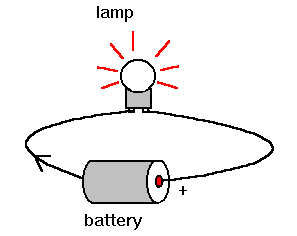Introduction to Electric Current
 The rate of flow of electric charge through a cross section of a conductor is called its “electric current.” Electric current is the directional flow of electrons in any material. The rate of charge flow past a given point in an electric circuit, measured in Coulombs/second, is named Amperes. One ampere is equivalent to one coulomb (6.24 × 1018 elementary charges) moving through a surface in one second. Materials that allow many electrons to move freely are called conductors and materials that do not allow electrons to flow very easily from one atom to another are called insulators.
The rate of flow of electric charge through a cross section of a conductor is called its “electric current.” Electric current is the directional flow of electrons in any material. The rate of charge flow past a given point in an electric circuit, measured in Coulombs/second, is named Amperes. One ampere is equivalent to one coulomb (6.24 × 1018 elementary charges) moving through a surface in one second. Materials that allow many electrons to move freely are called conductors and materials that do not allow electrons to flow very easily from one atom to another are called insulators.
Conductors are materials whose atoms have loosely bound electrons, whereas insulators are materials whose atoms have tightly bound electrons. The force required to make current flow through a conductor is called voltage and potential is the other term for voltage. An electric current in a wire creates a circular magnetic field around the wire, with its direction depending on that of the current.
I = Q/t
Electric currents do work by heating fires, lighting lamps, ringing bells, electroplating, etc.
Law of Electric Currents
A basic law of the universe is that like charges repel and unlike attract. Two negatives will repel each other.
A negative and a positive will attract each other. An electron has a negative charge.
The negative (-ve) terminal of a battery will therefore push negative electrons along a wire.
The positive (+ve) terminal of a battery will attract negative electrons along a wire.
Electric current will therefore flow from the -ve terminal of a battery, through the lamp, to the positive terminal. The current flows round the circuit.
Current Density
 Current density is defined as the average velocities of the positive and negative charges. The unit of current density is (C/m3)(m/s) = C/(m2s). The current density is a vector. It represents the amount of net charge that crosses a unit area perpendicular to the flow per second.
Current density is defined as the average velocities of the positive and negative charges. The unit of current density is (C/m3)(m/s) = C/(m2s). The current density is a vector. It represents the amount of net charge that crosses a unit area perpendicular to the flow per second.
If just as many negative as positive charges move across a unit area in the same direction per second, then the current density is zero. If more positive charges are moving, then the direction of the current density is the direction of the velocity of the positive charges. In ordinary conductors, the positive charges have zero average velocity and only the negative charges are moving. Consequently, the direction of the current density runs counter to the direction of the velocity of the negative charges, as shown in the diagram below.
The unit of current is Ampere = Coulomb/second (A = C/s). The current I is not a vector. It is a scalar, but can be a negative or positive number.
Example:
A 2 mm long cross section of wire is isolated and 20 C of charge is determined to pass through it in 40 s.
![]()
I = Q / t = (20 C) / (40 s) = 0.50 Ampere
Want to know more about electric currents? Click here to schedule a live session with an eAge eTutor!
About eAge Tutoring:
eAgeTutor.com is the premium online tutoring provider. Using materials developed by highly qualified educators and leading content developers, a team of top-notch software experts, and a group of passionate educators, eAgeTutor works to ensure the success and satisfaction of all of its students.
Contact us today to learn more about our guaranteed results and discuss how we can help make the dreams of the student in your life come true!